13th-14th Century
Donal Cooper (referenced below) has established that the high altar was originally across the nave, with the friars’ choir occupying the apse, transepts and crossing behind it. This use of a retro-choir was unusual before the Tridentine reforms of the 16th century (although Donal Cooper believes that it was commonplace in the early Franciscan churches of Umbria). Since the friars and the congregation were on opposite sides of the high altar, it necessitated double-sided altarpieces (see below).
Christus Patiens with St Francis (1272)
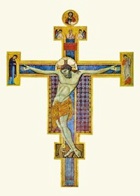
The Crucifix depicts the agony of the dying Christ:
-
✴The grieving Virgin and St John the Evangelist flank the outstretched arms of Christ;
-
✴a small half-length figure of the praying Virgin between angels terminates the vertical arm of the cross, with Christ the Redeemer in a tondo above; and
-
✴the stigmatised St Francis kneels at the foot of the cross, contemplating the wounds in the feet of Christ.
Double-sided Polyptych (ca. 1272)
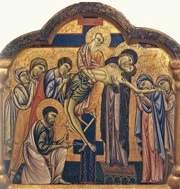
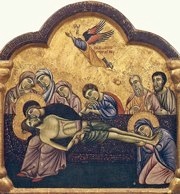
Deposition of Christ Lamentation
Ten widely dispersed panels (including the two illustrated above), which are attributed to the Maestro di San Francesco, were recognised in 1961 to have belonged to the earliest double-sided altarpiece of which we are aware. In 1982, Dillian Gordon (see the page on the artist) demonstrated that they constituted less than half those that were originally mounted in a monumental frame. She suggested that the altarpiece had originally been on the high altar of San Francesco al Prato. As noted above, this use of a double-sided altarpiece there arose because the friars had their choir behind the altar, while the congregation worshipped in the nave. The altarpiece and the Crucifix illustrated above probably both belonged to the same prestigious commission.
Dillian Gordon reconstructed this remarkably wide polyptych as follows:
-
✴The panels facing the friars in the choir of the church would have been (from left to right):
-
•a saint and/or prophet, probably St Francis (lost);
-
•two scenes from the Passion (lost);
-
•a saint and/or prophet, probably the prophet Jeremiah (lost);
-
•a central scene, probably of the Crucifixion (lost);
-
•the prophet Isaiah;
-
•the Deposition of Christ (Perugia, illustrated above);
-
•the Lamentation (Perugia, illustrated above); and
-
•St Antony of Padua (Perugia).
-
✴The panels facing the congregation in the nave would have been (from left to right):
-
•the stigmatised St Francis, whose Gospel is open at Galatians 2:19, “I have been crucified with Christ” (Perugia);
-
•SS Simon and Bartholomew (Metropolitan Museum, New York);
-
•St James Minor (National Gallery, Washington);
-
•St Andrew (only identified as such when a restoration in 1994 described him as the saint who evangelised “Patras”) (Perugia);
-
•a central scene, probably of the Madonna and Child (lost); and
-
•four other panels, including:
-
•St Peter (Perugia); and
-
•St John the Evangelist (National Gallery, Washington).
(In this list, “Perugia” indicates a panel that is now in the Galleria Nazionale).
The polyptych was replaced in 1403 (see below) and subsequently dismembered. The panels, which were probably moved initially to the sacristy, were subsequently dispersed.
-
✴The three panels that are now in America and the panel of St Peter passed to the Arciconfraternita della Pietà del Camposanto Teutonico, Rome at some point and were on-sold in 1921.
-
✴The panel of Isaiah was discovered at San Francesco, Assisi in 1919 and is now in the Museo del Tesoro di San Francesco.
-
✴All the panels that are now in the Galleria Nazionale, except the panel of St Peter, were acquired from local collectors over the five decades up to 1932.
-
✴The panel of St Peter found its way to a private collection in Brussels and was acquired by the Galleria Nazionale in 2001.
Period to 1536
As notes above, the friars commissioned a new double-sided altarpiece for their high altar in 1403 (see below). A guide of 1648 records the fact that the red marble high altar was reconsecrated in 1536. Donal Cooper (referenced below) points to documents that indicate that it had been moved back to the mouth of the apse in ca. 1530.
Panels from a polyptych (1403)
This double-sided polyptych, which is signed by Taddeo di Bartolo and dated by inscription, replaced an earlier polyptych on the high altar. This altarpiece seems to have been influential:
-
•it has been suggested as the inspiration for a similar altarpiece by Spinello Aretino for the high altar of San Francesco, Città di Castello (as described in more detail on the page on this church); and
-
•it certainly inspired the so-called Borgo San Sepolcro Altarpiece (1437-44), was commissioned from Sassetta for the high altar of San Francesco in the nearby Borgo San Sepolcro.
The “new” polyptych in San Francesco al Prato was probably dismantled in 1536, the date at which the altar was moved backwards into the apse and re-consecrated. The individual panels were moved to the sacristy and then, in 1810, to the Accademia di Belle Arti. The panels of SS Peter and Paul were taken to the Musei Capitolini, Rome in 1812 but returned to Perugia in 1817.
Modern scholarship has revealed that the polyptych originally comprised seven vertical planks, each of which was painted on both sides and each side of which had images in three registers. These planks were subsequently split into the 42 individual images.
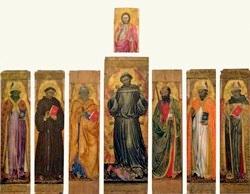
The seven panels from the central register of the side that faced the retro-choir are all exhibited in the Galleria Nazionale. They depict:
-
✴St Francis in a mandorla borne by angels, displaying all five wounds of his stigmatisation and crushing Lust, Power and Greed (in the central panel);
-
✴SS Herculanus, Antony of Padua and Peter (on the left); and
-
✴SS Paul, Constantius and Louis of Toulouse (on the right).
The whereabouts of two other panels that probably came from this side of the polyptych are known:
-
✴The panel from the centre of the upper register that depicts Christ displaying his wounds found its way to the gallery separately from the others.
-
✴A small panel in the Musée du Louvre, Paris that depicts of the Crucifixion with St Francis at the foot of the cross, possibly came from the central part of the predella.
The placing of these two panels respectively above and below the central panel of St Francis displaying his wounds constitutes one of the earliest depictions of him as "alter Christus" (the second Christ).
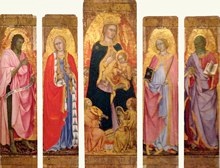
The inner five of the seven panels from the main register of the side that faced the congregation are also exhibited in the gallery. They depict:
-
✴the Madonna and Child with musical angels (in the central panel);
-
✴SS John the Baptist and Mary Magdalene (on the left); and
-
✴SS Catherine of Alexandria and John the Evangelist (on the right).
Two other panels from this side also survive:
-
✴The figure of St Elizabeth of Hungary, which came from the extreme right of the main register, is now in the Perkins collection in the Museo del Tesoro di San Francesco, Assisi.
-
✴The figure of Christ blessing, which came from the upper register of the central panel, is now in the Yale University Art Gallery, New Haven, Connecticut.
Six small panels of scenes from the life of St Francis in the Niedersächsischen Landesgallerie, Hannover and a seventh in the Van Heek Collection, Heerenberg, Holland came from the predella.
Tombstone of Angelo del Toscano (ca. 1457)
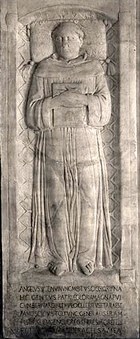
Fra Angelo had been the prime mover behind the construction of the Oratorio di San Bernardino in 1451-2. His monument is usually dated to ca. 1457, after Agostino di Duccio was commissioned to work on its facade. His memorial stone was moved to the oratory in the early 20th century and is now on left wall there.
Sarcophagus of Braccio Fortebracci (1505 ?)
Braccio Fortebracci, Lord of Perugia, met his death in 1424 outside Aquila in Southern Italy, during the interminable war for the succession to the crown of Naples. His enemy, Pope Martin V denied him burial on sacred ground. However, his nephew Nicolò della Stella Fortebracci and two Perugian ambassadors, Francesco Coppoli and Giovanni di Petruccio Montesperelli managed to retrieve his remains in 1432 (the year following the death of Martin V), and he was buried in the choir of San Francesco.
According to Umberto Gnoli (referenced on the page on the artist), Fiorenzo di Lorenzo painted the wooden sarcophagus in 1505. A wooden sarcophagus that purports to contain the remains survives, but if it is the one painted by Fiorenzo di Lorenzo it has been heavily repainted. It has suffered a number of moves over the centuries [and is now in the sacristy ??]
Period 1536 - 1737
When the roof of San Francesco al Prato collapsed in 1737, the high altar was still at the mouth of the apse, above a flight of four steps.
Choir (ca. 1530-60)
In 1532, the friars wrote to Giovanni Battista Bastoni, asking him to accelerate his work of the choir of their church, probably in anticipation of the consecration of the high altar in 1536. However, he probably died soon after. His son, Eusebio Bastoni received payment for the completion of the work in 1560.
Tabernacle (1592-1602)
The friars commissioned Fiorenzo di Giuliano to build a magnificent gilded tabernacle, including some 40 statues, for their high altar. They made the final payment for it in 1602. Unfortunately, it no longer survives.
Crucifix (16th century)

Read more:
D. Cooper, “Franciscan Choir Enclosures and the Function of Double-Sided Altarpieces in Pre-Tridentine Umbria”, Journal of the Warburg and Courtauld Institutes, 64 (2001) 1-54
San Francesco al Prato: Main page Relics of Blessed Giles
Art from Choir Art from Exterior Chapels Other Art from Church
Return to Monuments of Perugia



